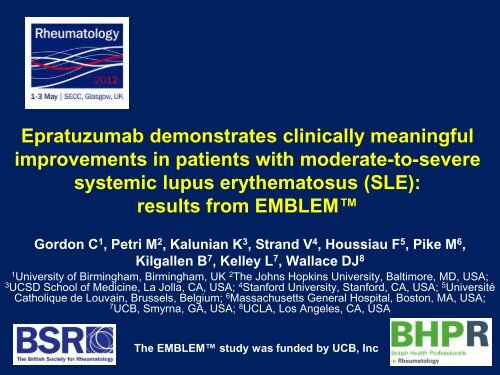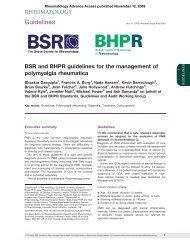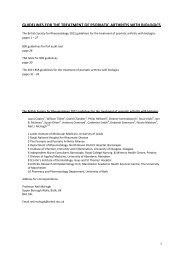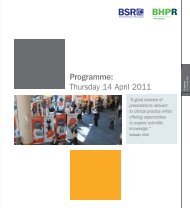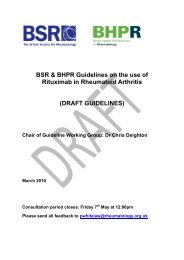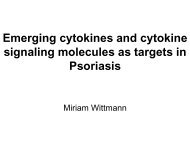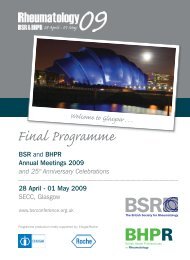Epratuzumab Demonstrates Clinically Meaningful Improvements in ...
Epratuzumab Demonstrates Clinically Meaningful Improvements in ...
Epratuzumab Demonstrates Clinically Meaningful Improvements in ...
You also want an ePaper? Increase the reach of your titles
YUMPU automatically turns print PDFs into web optimized ePapers that Google loves.
<strong>Epratuzumab</strong> demonstrates cl<strong>in</strong>ically mean<strong>in</strong>gful<br />
improvements <strong>in</strong> patients with moderate-to-severe<br />
systemic lupus erythematosus (SLE):<br />
results from EMBLEM<br />
Gordon C 1 , Petri M 2 , Kalunian K 3 , Strand V 4 , Houssiau F 5 , Pike M 6 ,<br />
Kilgallen B 7 , Kelley L 7 , Wallace DJ 8<br />
1<br />
University of Birm<strong>in</strong>gham, Birm<strong>in</strong>gham, UK 2 The Johns Hopk<strong>in</strong>s University, Baltimore, MD, USA;<br />
3<br />
UCSD School of Medic<strong>in</strong>e, La Jolla, CA, USA; 4 Stanford University, Stanford, CA, USA; 5 Université<br />
Catholique de Louva<strong>in</strong>, Brussels, Belgium; 6 Massachusetts General Hospital, Boston, MA, USA;<br />
7<br />
UCB, Smyrna, GA, USA; 8 UCLA, Los Angeles, CA, USA<br />
The EMBLEM study was funded by UCB, Inc
Disclosures<br />
Actelion<br />
Amgen<br />
Aspreva<br />
Biogen<br />
BMS<br />
Genentech<br />
GSK<br />
HGS<br />
Immunomedics<br />
MedImmune<br />
Merck Serono<br />
Roche<br />
UCB<br />
Vifor Pharma<br />
Consultant/received honoraria from UCB and Immunomedics
<strong>Epratuzumab</strong><br />
• Humanised IgG1<br />
• Targett<strong>in</strong>g-CD22 monoclonal<br />
antibody<br />
• Causes rapid but only partial<br />
decrease <strong>in</strong> B cell numbers<br />
• No obvious CDC and<br />
apoptosis, but partial ADCC of<br />
B cells <strong>in</strong> vitro<br />
• Induces phosphorylation and<br />
<strong>in</strong>ternalisation of CD22;<br />
potential for effects on<br />
signall<strong>in</strong>g through CD22<br />
• Alters expression of adhesion<br />
molecules<br />
• Modulates activation,<br />
proliferation and migration of<br />
B cells<br />
<strong>Epratuzumab</strong> was licensed by Immunomedics to<br />
UCB for all autoimmune disease <strong>in</strong>dications<br />
Fab<br />
(CD22 b<strong>in</strong>d<strong>in</strong>g)<br />
IgG 1 Fc<br />
Brown D, et al. Ann Rheum Dis 2010;69(Suppl3):490<br />
Hu C, et al. Cl<strong>in</strong> Exp Immunol 2009;157:181–190<br />
Wallace DJ, et al. Arthritis & Rheum 2009;61:1168–1178<br />
Levesque MC. Cl<strong>in</strong> Exp Immunol 2009;157:198–208<br />
Jacobi AM, et al. Ann Rheum Dis 2008;67:450–457<br />
Daridon C, et al. Arthritis Res Ther 2010; 12:R204
<strong>Epratuzumab</strong> cl<strong>in</strong>ical trial program lead<strong>in</strong>g<br />
up to EMBLEM<br />
• Open-label pilot study suggested benefit <strong>in</strong> SLE<br />
– few significant adverse events and no evidence of<br />
immunogenicity<br />
• In 2 placebo-controlled, randomized trials <strong>in</strong> moderate or severe<br />
SLE, epratuzumab (360 or 720 mg/m 2 ) was associated with:<br />
– cl<strong>in</strong>ically mean<strong>in</strong>gful reductions <strong>in</strong> disease activity<br />
– improved health-related quality of life<br />
– reduced corticosteroid consumption compared with placebo<br />
Dorner T, et al. Arthritis Res Ther 2006;8:R74<br />
Petri M, et al. Arthritis Rheum 2008;57(suppl):1087<br />
Strand V, et al. Arthritis Rheum 2008;57(suppl):1086<br />
Wallace D, et al. Arthritis Rheum 2008;57(suppl):1088
EMBLEM study groups and design<br />
A 12-week, multi-center, randomized, double-bl<strong>in</strong>d, placebo-controlled, phase IIb<br />
study to assess the efficacy and safety of epratuzumab and to determ<strong>in</strong>e a dose<br />
regimen <strong>in</strong> patients with moderate to severe SLE<br />
Screen<strong>in</strong>g<br />
Day –14 to –1<br />
227 patients<br />
randomized<br />
Stratified by<br />
disease<br />
severity<br />
and IS use<br />
Double-bl<strong>in</strong>d period<br />
Placebo, n=38<br />
<strong>Epratuzumab</strong> 200 mg cd (100 mg EOW) n=39<br />
<strong>Epratuzumab</strong> 800 mg cd (400 mg EOW) n=38<br />
<strong>Epratuzumab</strong> 2,400 mg cd (600 mg weekly) n=37 a<br />
<strong>Epratuzumab</strong> 2,400 mg cd (1,200 mg EOW) n=37<br />
<strong>Epratuzumab</strong> 3,600 mg cd (1,800 mg EOW) n=38<br />
Safety follow-up<br />
or entry <strong>in</strong>to<br />
open-label<br />
extension study<br />
0 1 2 3 12<br />
24<br />
Primary end po<strong>in</strong>t<br />
Infusions<br />
Weeks<br />
a<br />
2 patients randomized but never received drug; safety population, n=225<br />
cd = cumulative dose; EOW = every other week; IS = immunosuppressants
Key <strong>in</strong>clusion and exclusion criteria<br />
Inclusion criteria<br />
• Aged ≥18 years<br />
• Positive for anti-nuclear antibody<br />
(≥1:40) at screen<strong>in</strong>g<br />
• Current SLE accord<strong>in</strong>g to ACR<br />
revised criteria (exclud<strong>in</strong>g neuro)<br />
• BILAG level A <strong>in</strong> ≥1 body/organ<br />
system or level B <strong>in</strong> ≥2 systems<br />
<strong>in</strong>volv<strong>in</strong>g mucocutaneous,<br />
musculoskeletal or<br />
cardiovascular/respiratory<br />
• SLEDAI total score ≥6<br />
• On stable dosages of oral<br />
corticosteroids and antimalarials,<br />
azathiopr<strong>in</strong>e, methotrexate or<br />
mycophenolate<br />
Exclusion criteria<br />
• Active, severe neuropsychiatric SLE<br />
• Renal impairment, any of:<br />
– Active severe renal disease<br />
(def<strong>in</strong>ed by BILAG renal level A<br />
or Grade III or higher WHO<br />
nephritis)<br />
– Serum creat<strong>in</strong><strong>in</strong>e >2.5 mg/dL<br />
– Significant serum creat<strong>in</strong><strong>in</strong>e<br />
<strong>in</strong>crease with<strong>in</strong> the 28 days prior<br />
to Visit 1 (screen<strong>in</strong>g)<br />
– Prote<strong>in</strong>uria >3.5 gm/day<br />
• Pregnant or lactat<strong>in</strong>g<br />
• Evidence of an immunosuppressive<br />
state
Patient disposition<br />
Randomized (ITT)<br />
n=227<br />
Placebo<br />
n=38<br />
<strong>Epratuzumab</strong><br />
200 mg cd<br />
(100 mg EOW)<br />
n=39<br />
<strong>Epratuzumab</strong><br />
800 mg cd<br />
(400 mg EOW)<br />
n=38<br />
<strong>Epratuzumab</strong><br />
2,400 mg cd<br />
(600 mg weekly)<br />
n=37<br />
<strong>Epratuzumab</strong><br />
2,400 mg cd<br />
(1,200 mg EOW)<br />
n=37<br />
<strong>Epratuzumab</strong><br />
3,600 mg cd<br />
(1,800 mg EOW)<br />
n=38<br />
Premature<br />
discont<strong>in</strong>uations,<br />
n=2 (5.3%):<br />
adverse event ,<br />
n=1;<br />
lack of efficacy,<br />
n=1<br />
Premature<br />
discont<strong>in</strong>uations,<br />
n=6 (15.4%):<br />
lack of efficacy,<br />
n=3;<br />
loss of efficacy,<br />
n=2;<br />
withdrew<br />
consent, n=1<br />
Premature<br />
discont<strong>in</strong>uations,<br />
n=6 (15.8%):<br />
adverse event,<br />
n=1;<br />
lack of efficacy,<br />
n=4;<br />
protocol<br />
violation, n=1<br />
Premature<br />
discont<strong>in</strong>uations,<br />
n=8 (21.6%):<br />
adverse event,<br />
n=2;<br />
lack of efficacy,<br />
n=1;<br />
loss of efficacy,<br />
n=1;<br />
protocol<br />
violation, n=2;<br />
other reasons,<br />
n=2<br />
Premature<br />
discont<strong>in</strong>uations,<br />
n=3 (8.1%):<br />
adverse event,<br />
n=1;<br />
lack of efficacy,<br />
n=1;<br />
loss of efficacy,<br />
n=1<br />
Premature<br />
discont<strong>in</strong>uations,<br />
n=3 (7.9%):<br />
adverse event,<br />
n=1;<br />
lack of efficacy,<br />
n=1;<br />
loss of efficacy,<br />
n=1<br />
Completed<br />
12 weeks<br />
n=36<br />
(94.7%)<br />
Completed<br />
12 weeks<br />
n=33<br />
(84.6%)<br />
Completed<br />
12 weeks<br />
n=32<br />
(84.2%)<br />
Completed<br />
12 weeks<br />
n=29<br />
(78.4%)<br />
Completed<br />
12 weeks<br />
n=34<br />
(91.9%)<br />
Completed<br />
12 weeks<br />
n=35<br />
(92.1%)
Patient demographics and disease<br />
characteristics<br />
<strong>Epratuzumab</strong><br />
<strong>Epratuzumab</strong><br />
Placebo<br />
(n=38)<br />
600 mg weekly<br />
(n=35)<br />
1,200 mg EOW<br />
(n=37)<br />
Mean age (years)<br />
41.1<br />
36.8<br />
37.2<br />
Range<br />
22–64<br />
19–68<br />
18–57<br />
Female (%) 86.8 100 100<br />
Racial group (%)<br />
Caucasian/Black/Asian* 78.9/5.3/13.2 85.7/8.6/5.7 67.6/10.8/16.2<br />
Mean total BILAG score a (SD) 15.6 (5.8) 14.34 (6.8) 14.9 (7.6)<br />
Mean total SLEDAI score (SD) 15.5 (7.1) 14.4 (8.5) 16.02 (6.2)<br />
Immunosuppressants (%) 47.4 37.1 48.6<br />
Anti-malarials (%) 47.4 45.7 48.6<br />
Corticosteroid use (mg/day prednisone equivalent)<br />
Mean (SD) 13.4 (10.6) 13.2 (10.6) 16.1 (9.9)<br />
Dosage >30 mg/day (%) 7.9 8.6 2.7<br />
*Asian <strong>in</strong>cluded Indian and Hong Kong sites.<br />
a<br />
Total BILAG-2004 <strong>in</strong>dex score based on convention of A=9; B=3; C=1; D=0; E=0<br />
BILAG, British Isles Lupus Assessment Group; SD, standard deviation; EOW, every other week;<br />
SLEDAI, SLE Disease Activity Index
Severe (BILAG A) disease at basel<strong>in</strong>e<br />
(safety population)<br />
• 71% of patients with ≥1 BILAG-2004 <strong>in</strong>dex A score<br />
• Most patients had BILAG A and B disease <strong>in</strong> multiple systems at basel<strong>in</strong>e<br />
BILAG body/organ<br />
system (severe<br />
disease can be<br />
present <strong>in</strong> >1 system)<br />
Placebo<br />
(n=38)<br />
Emab<br />
100 mg<br />
EOW<br />
(n=39)<br />
Emab<br />
400 mg<br />
EOW<br />
(n=37)<br />
Emab<br />
600 mg<br />
weekly<br />
(n=35)<br />
Emab<br />
1,200 mg<br />
EOW<br />
(n=37)<br />
Emab<br />
1,800 mg<br />
EOW<br />
(n=39)<br />
Mucocutaneous (%) 42.1 35.9 32.4 34.3 24.3 28.2<br />
Musculoskeletal (%) 26.3 41.0 24.3 34.3 35.1 30.8<br />
Cardiorespiratory (%) 23.7 12.8 21.6 11.4 16.2 28.2<br />
Neuropsychiatric (%) 2.6 5.1 13.5 0 5.4 17.9<br />
Constitutional (%) 2.6 5.1 2.7 2.9 5.4 0<br />
Renal (%) 0 0 2.7 0 0 0<br />
Ophthalmic (%) 0 0 2.7 2.9 0 0<br />
Gastro<strong>in</strong>test<strong>in</strong>al (%) 2.6 0 0 2.9 0 2.6<br />
Hematological (%) 0 0 2.7 0 0 0<br />
Emab = epratuzumab; EOW = every other week
Primary end po<strong>in</strong>t: a comb<strong>in</strong>ed responder <strong>in</strong>dex<br />
“BILAG-based Comb<strong>in</strong>ed Lupus Assessment”<br />
(BICLA) at Week 12<br />
Def<strong>in</strong>ition of a BICLA treatment response:<br />
Improvement:*<br />
1 All BILAG a level A scores improved to B/C/D and<br />
2 All BILAG a level B scores improved to C/D<br />
No worsen<strong>in</strong>g:*<br />
1 No s<strong>in</strong>gle new BILAG A & not > 1 new BILAG B scores and<br />
2 No worsen<strong>in</strong>g of basel<strong>in</strong>e SLEDAI total score and<br />
3 No worsen<strong>in</strong>g <strong>in</strong> PGA (< 10% worsen<strong>in</strong>g from basel<strong>in</strong>e)<br />
No treatment failure*: Treatment failure def<strong>in</strong>ed as non-protocol treatment, e.g.<br />
new or <strong>in</strong>creased immunosuppressants or antimalarials;<br />
and no requirement for prohibited concomitant medications<br />
*Each requirement <strong>in</strong>cludes those listed below it <strong>in</strong> the table, i.e. improvement also<br />
requires no worsen<strong>in</strong>g and no treatment failure.<br />
a<br />
BILAG-2004 version, scored by <strong>in</strong>dependent central efficacy reader
BICLA response at Week 12<br />
(ITT population)<br />
p=0.03<br />
p=0.07<br />
p=0.02<br />
Placebo Emab Emab Emab Emab Emab Emab<br />
(n=38) 100 mg 400 mg 600 mg 1,200 mg 2,400 mg 1,800 mg<br />
EOW EOW weekly EOW comb<strong>in</strong>ed EOW<br />
(n=39) (n=38) (n=37) a (n=37) (n=74) (n=38)<br />
a<br />
2 patients randomized but not treated<br />
Emab = epratuzumab; EOW = every other week<br />
p values were not adjusted for multiple comparisons and are based on an exploratory post-hoc analysis<br />
p value for all 6 treatment arms for overall treatment effect assessed <strong>in</strong> primary analysis = 0.148
Odds ratios and 95% confidence <strong>in</strong>tervals<br />
vs placebo (ITT population)<br />
Emab 1,800 mg EOW (n=38)<br />
1.2<br />
Emab 2,400 mg comb<strong>in</strong>ed (n=74)<br />
Emab 1,200 mg EOW (n=37)<br />
Emab 600 mg weekly (n=37) a<br />
2.6<br />
2.9<br />
3.2<br />
p=0.02<br />
vs placebo<br />
p=0.07<br />
vs placebo<br />
p=0.03<br />
vs placebo<br />
Emab 400 mg EOW (n=38)<br />
1.3<br />
Emab 100 mg EOW (n=39)<br />
1.7<br />
-1 0 1 2 3 4 5 6 7 8 9 10<br />
Odds ratio versus placebo<br />
a<br />
2 patients randomized but never received drug<br />
Emab = epratuzumab; EOW = every other week<br />
p values were not adjusted for multiple comparisons and are based on an exploratory post-hoc analysis<br />
p value for all 6 treatment arms for overall treatment effect assessed <strong>in</strong> primary analysis = 0.148
Responders (%)<br />
BICLA response rates<br />
at Weeks 8 and 12 (ITT population)<br />
50<br />
40<br />
Week 8<br />
Week 12<br />
37.8<br />
45.9<br />
35.1<br />
40.5<br />
30<br />
20<br />
21.1<br />
21.1<br />
30.8<br />
30.8<br />
28.9<br />
26.3<br />
18.4<br />
23.7<br />
10<br />
0<br />
Placebo Emab Emab Emab Emab Emab<br />
(n=38) 100 mg 400 mg 600 mg 1,200 mg 1,800 mg<br />
EOW EOW weekly EOW EOW<br />
(n=39) (n=38) (n=37) a (n=37) (n=38)<br />
<strong>Cl<strong>in</strong>ically</strong> mean<strong>in</strong>gful responses observed at Week 8, with further improvement to Week 12<br />
a<br />
2 patients randomized but never received drug<br />
EOW = every other week
Responders (%)<br />
BILAG and enhanced BILAG<br />
improvement (Week 12, ITT population)<br />
70<br />
60<br />
BILAG response (primary end po<strong>in</strong>t)<br />
Enhanced BILAG response<br />
62.1<br />
50<br />
44.1<br />
40<br />
30<br />
30.6<br />
36.4<br />
34.4<br />
28.6<br />
20<br />
10<br />
0<br />
22.2<br />
27.3<br />
12.5<br />
37.9 35.3<br />
Placebo Emab Emab Emab Emab Emab<br />
(n=38) 100 mg 400 mg 600 mg 1,200 mg 1,800 mg<br />
EOW EOW weekly EOW EOW<br />
(n=39) (n=38) (n=37) a (n=37) (n=38)<br />
22.9<br />
a<br />
2 patients randomized but never received drug<br />
Enhanced BILAG response = BILAG A/B scores at study entry <strong>in</strong> all body systems improv<strong>in</strong>g to C/D,<br />
with ‘no BILAG worsen<strong>in</strong>g’ <strong>in</strong> other BILAG organ systems (no new BILAG A or ≥2 new BILAG B scores)<br />
EOW = every other week
Improvement from basel<strong>in</strong>e to Week 12 <strong>in</strong><br />
mucocutaneous body system<br />
A (very active)<br />
B (moderate activity)<br />
C (mild activity)<br />
D (no activity but<br />
previously affected)<br />
Placebo<br />
(n=31) a<br />
<strong>Epratuzumab</strong><br />
600 mg weekly<br />
(n=32) a<br />
<strong>Epratuzumab</strong><br />
1,200 mg EOW<br />
(n=32) a<br />
a<br />
Number of patients with BILAG A/B at basel<strong>in</strong>e (ITT population)
Improvement from basel<strong>in</strong>e to Week 12 <strong>in</strong><br />
musculoskeletal body system<br />
A (very active)<br />
B (moderate activity)<br />
C (mild activity)<br />
D (no activity but<br />
previously affected)<br />
Placebo<br />
(n=31) a<br />
<strong>Epratuzumab</strong><br />
600 mg weekly<br />
(n=35) a<br />
<strong>Epratuzumab</strong><br />
1,200 mg EOW<br />
(n=34) a<br />
a<br />
Number of patients with BILAG A/B at basel<strong>in</strong>e (ITT population)
Improvement from basel<strong>in</strong>e to Week 12 <strong>in</strong><br />
cardiorespiratory body system<br />
A (very active)<br />
B (moderate activity)<br />
C (mild activity)<br />
D (no activity but<br />
previously affected)<br />
Placebo<br />
(n=17) a<br />
<strong>Epratuzumab</strong><br />
600 mg weekly<br />
(n=7) a<br />
<strong>Epratuzumab</strong><br />
1,200 mg EOW<br />
(n=9) a<br />
a<br />
Number of patients with BILAG A/B at basel<strong>in</strong>e (ITT population)
Treatment-emergent adverse events<br />
(safety population)<br />
Placebo<br />
(n=38)<br />
<strong>Epratuzumab</strong><br />
600 mg<br />
weekly (n=35)<br />
<strong>Epratuzumab</strong><br />
1,200 mg EOW<br />
(n=37)<br />
Patients report<strong>in</strong>g ≥1 AE (%) 71.7 77.1 78.4<br />
Infusion reactions (%) 10.5 14.3 16.2<br />
AEs lead<strong>in</strong>g to discont<strong>in</strong>uation (%) 5.3 2.9 2.7<br />
Drug-related AEs (%) 21.1 37.1 43.2<br />
AEs possibly <strong>in</strong>dicative of <strong>in</strong>fection (%) 39.5 45.7 43.2<br />
SAEs (%) 7.9 8.6 10.8<br />
AE = adverse event; Emab = epratuzumab; EOW = every other week;<br />
SAE = serious adverse event
Conclusions<br />
• <strong>Epratuzumab</strong> at a cumulative dose of 2,400 mg* was associated<br />
with mean<strong>in</strong>gful and statistically significant improvements <strong>in</strong><br />
disease activity<br />
– <strong>Epratuzumab</strong> 600 mg weekly associated with greater improvement<br />
<strong>in</strong> BILAG-2004 scores (from A/B to C/D) than placebo <strong>in</strong> all 6<br />
affected body systems<br />
– Responder rates were more than twice those of placebo<br />
• <strong>Epratuzumab</strong> was well tolerated<br />
– Incidence of AEs comparable to placebo with no new<br />
safety signals<br />
• EMBLEM is the first study to use BICLA<br />
– a BILAG-2004 <strong>in</strong>dex based composite end po<strong>in</strong>t<br />
*Cumulative dose of 2,400 mg <strong>in</strong>cludes patients who received epratuzumab 600 mg weekly for 4 weeks<br />
and patients who received epratuzumab1,200 mg every other week (EOW) for 2 weeks


